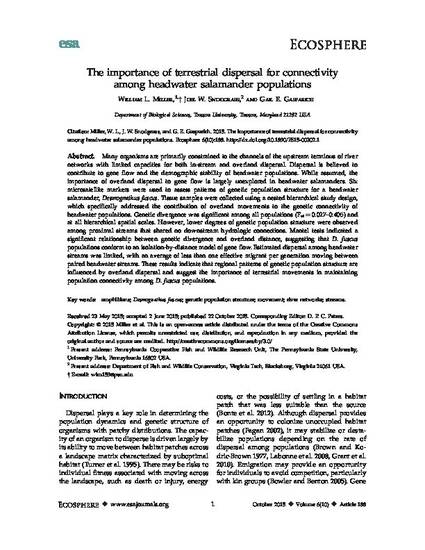
Article
The Importance of Terrestrial Dispersal for Connectivity Among Headwater Salamander Populations
Ecosphere
(2015)
Abstract
Many organisms are primarily constrained to the channels of the upstream terminus of river networks with limited capacities for both in‐stream and overland dispersal. Dispersal is believed to contribute to gene flow and the demographic stability of headwater populations. While assumed, the importance of overland dispersal to gene flow is largely unexplored in headwater salamanders. Six microsatellite markers were used to assess patterns of genetic population structure for a headwater salamander, Desmognathus fuscus. Tissue samples were collected using a nested hierarchical study design, which specifically addressed the contribution of overland movements to the genetic connectivity of headwater populations. Genetic divergence was significant among all populations (Fst = 0.027–0.405) and at all hierarchical spatial scales. However, lower degrees of genetic population structure were observed among proximal streams that shared no downstream hydrologic connections. Mantel tests indicated a significant relationship between genetic divergence and overland distance, suggesting that D. fuscus populations conform to an isolation‐by‐distance model of gene flow. Estimated dispersal among headwater streams was limited, with an average of less than one effective migrant per generation moving between paired headwater streams. These results indicate that regional patterns of genetic population structure are influenced by overland dispersal and suggest the importance of terrestrial movements in maintaining population connectivity among D. fuscus populations.
Disciplines
Publication Date
October 22, 2015
DOI
10.1890/ES15-00302.1
Citation Information
William L. Miller, Joel W. Snodgrass and Gail E. Gasparich. "The Importance of Terrestrial Dispersal for Connectivity Among Headwater Salamander Populations" Ecosphere Vol. 6 Iss. 10 (2015) p. 1 - 9 Available at: http://works.bepress.com/gail-gasparich/10/
Creative Commons license

This work is licensed under a Creative Commons CC_BY International License.
